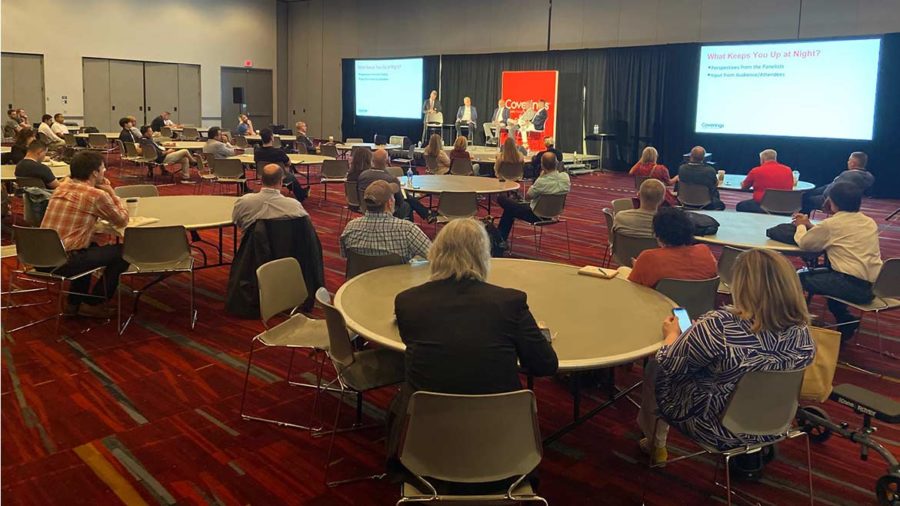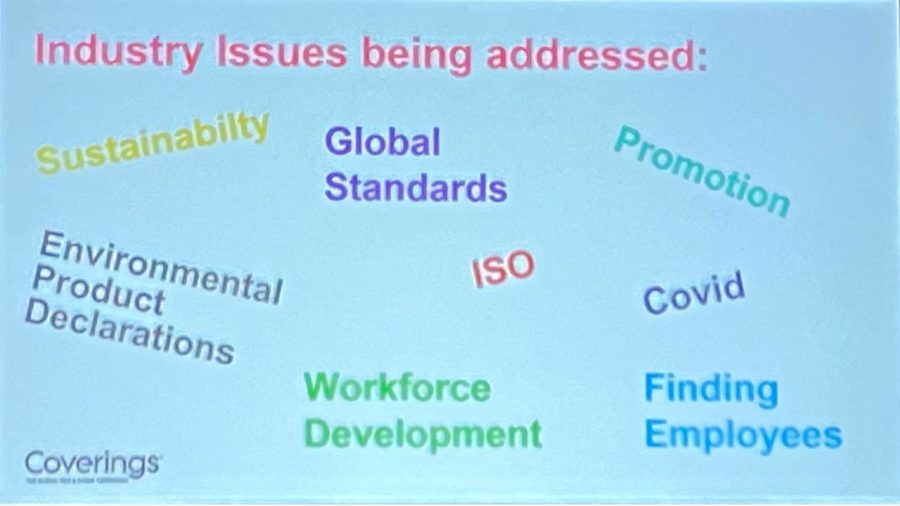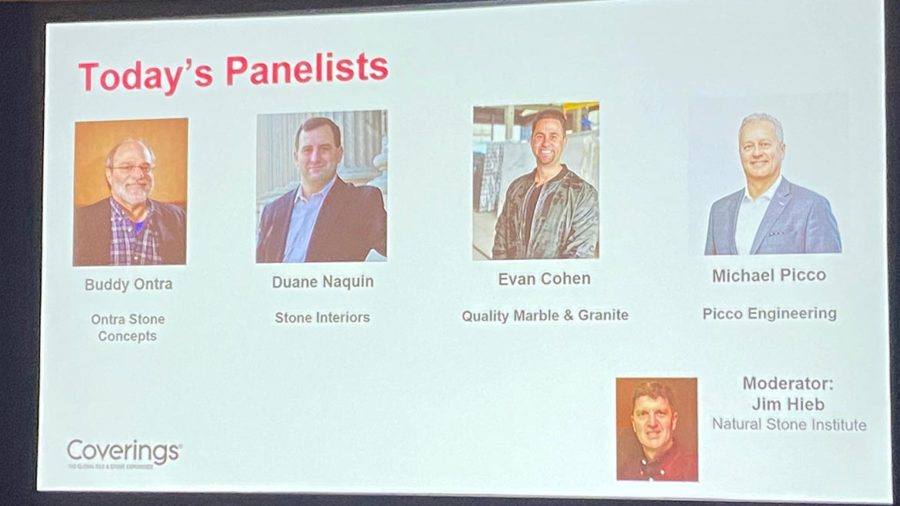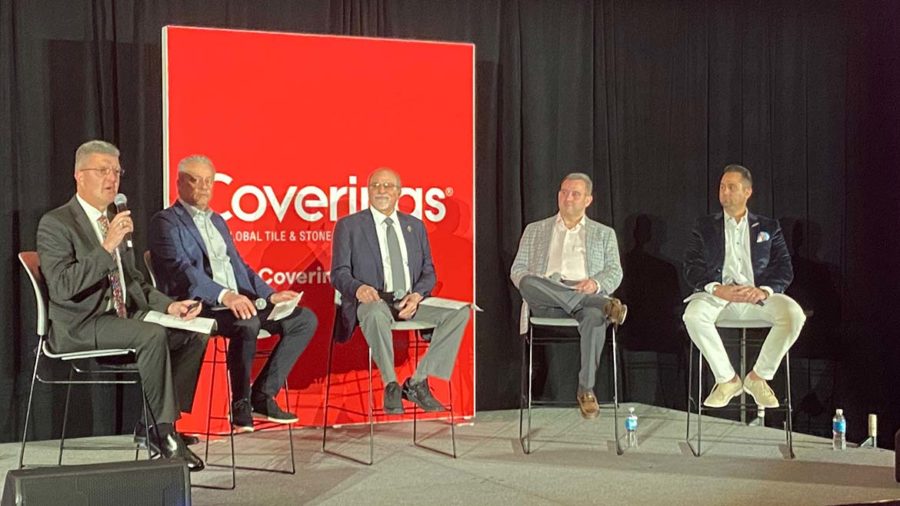No products in the cart.
Members of the Natural Stone Institute executive board gathered to discuss the “State of the Stone Industry” on the morning of Tuesday, April 5th – the start of Coverings 2022 in Las Vegas, NV. Topics ranged from government regulation, competing product challenges and forecasting market growth. The panel, moderated by Jim Hieb, CEO of the Natural Stone Institute, comprised:
- Buddy Ontra, Ontra Stone Concepts
- Duane Naquin, Stone Interiors
- Evan Cohen, Quality Marble & Granite
- Michael Picco, Picco Engineering
“We are thankful to Coverings for the opportunity to share some news about the industry, as well as perspectives from the Natural Stone Institute,” said Hieb. “It is nice to have representation from several segments of the industry on our panel today.” He emphasized to the audience that participation was encouraged.
Sustainability
“Some of our audience may not be aware that a growing number of companies in North America are gaining an ANSI sustainability standard and educating the design community about how to apply it to achieve their green building objectives. “We know natural stone is sustainable, but we have to prove it by setting standards,” said Hieb.
Picco explained that the Natural Stone Sustainability Standard examines and verifies, through a third party, numerous areas of stone production – effectively improving the baseline for the environmental performance of natural stone. “It addresses water, energy custody and transportation, chain of custody, chemicals and materials, excess material, innovation, site management, land reclamation, human health and safety, and corporate governance.”
Hieb explained to attendees that this standard was a critical initiative when Picco was board president. “Buddy, we continue to work on it during your term as well,” he said. “From your perspective, why is this important?”
“Mike started this train rolling and it’s not going to stop,” said Ontra. “This issue is important to the design community. It is critical that we tell our story through certification so that we can show our competitive advantage over other materials – especially manmade imitations. Quite simply, it is an opportunity to identify changes that reduce our carbon footprint without reducing productivity.”
Picco stressed the importance to have a global discussion about the growing importance of Environmental Product Declarations (EPDs). It was shared that the Natural Stone Institute will be publishing three industry EPDs in August.
Global Standards for Natural Stone
“Just prior to the COVID pandemic, the industry learned about an ISO plan to create a global standard that would combine both manmade stone and natural stone into one standard,” said Hieb. “We successfully persuaded ISO to separate this effort into two standards, and now the Natural Stone Institute is the lead organization to create the natural stone standard.”
Hieb asked Cohen to share some perspectives on why the board under took this initiative. “Being able to have a single uniform standard will be instrumental,” he said. “First, I am pleased that the standard was separated. This will preserve the marketplace for natural stone by reducing confusion between natural stone and engineered stone. There are often projects where the quarry source, fabrication process and installation are occurring in different countries – or even different continents. Having globally unified standards through ISO will give all parties a common ground and help eliminate confusion.”
Hieb explained that the Natural Stone Institute accepted a leadership role in creating the natural stone standard. “Our technical director has accepted a five-year chair role with ISO. It takes three years to develop an ISO standard, and we are just beginning the second year.”
According to Naquin, the global standard will accomplish several points:
- Provide a single global standard that all stone companies can refer to regarding all things natural stone.
- Alleviate misunderstandings and miscommunications for all parties involved in a project.
- Save companies money by cutting costs through improved systems and procedures.
- Preserve market share for natural stone by reducing confusion between natural stone and manmade products.
Other Industry Issues
Hieb then steered the panel to discuss other issues that are on their mind. “Supply chain issues have created a huge challenge for everyone,” said Cohen. “Products that we usually were getting in 20 days, we are now waiting on for 60 to 90 days. Also, on a job, we are getting held up waiting for the cabinets or something else. Then we are sitting on products.”
Cohen’s advice to the audience was “Never let a good crisis go to waste.” “Since 2020, we have learned we have to adapt.”
Labor shortages and workforce development were also addressed. The Natural Stone Institute has an online training platform, Natural Stone University, which holds nearly 250 hours of training for natural stone professionals. A broad range of topics are covered and presented through videos, reading materials and comprehension tests.
Naquin explained there are several steps to be completed and then the final stage of the Natural Stone Institute Training Program will be to file for national apprenticeship guideline through the Department of Labor.
“Both the tile and wood flooring industries have said guidelines and have offered assistance to us,” said Ontra. “This should be a great resource for the industry once completed.”




